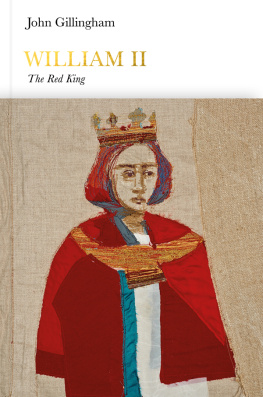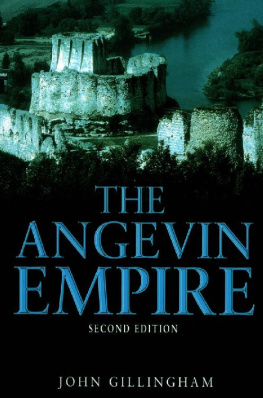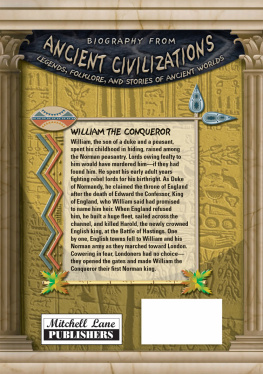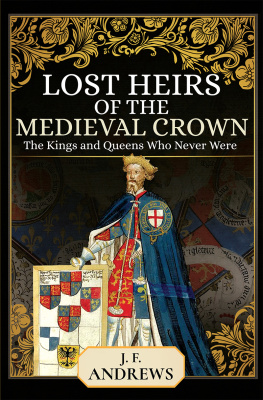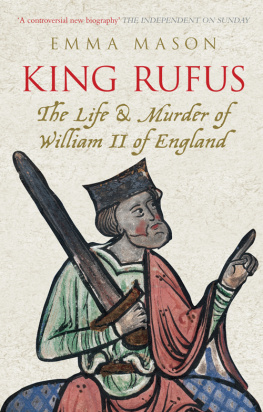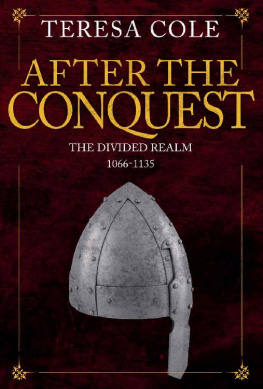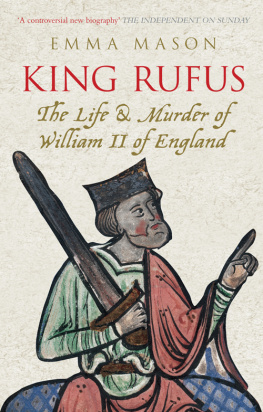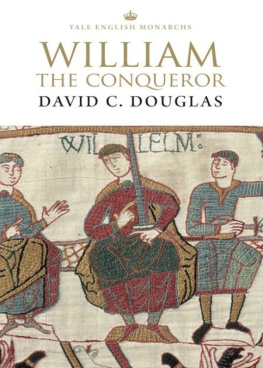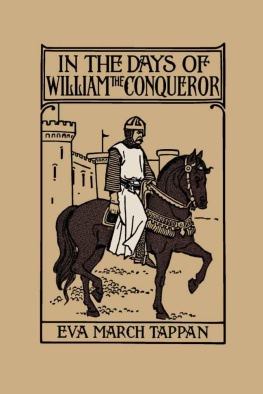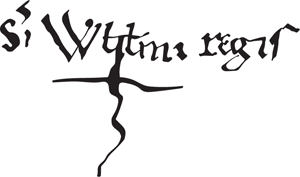Contents
John Gillingham
WILLIAM II
The Red King
ALLEN LANE
UK | USA | Canada | Ireland | Australia
India | New Zealand | South Africa
Allen Lane is part of the Penguin Random House group of companies whose addresses can be found at global.penguinrandomhouse.com.
First published 2015
Copyright John Gillingham, 2015
Cover Design by Pentagram
Jacket art by Nick Higgins
The moral right of the author has been asserted
ISBN: 978-0-141-97856-7
THE BEGINNING
Let the conversation begin...
Follow the Penguin Twitter.com@penguinukbooks
Keep up-to-date with all our stories YouTube.com/penguinbooks
Pin Penguin Books to your Pinterest
Like Penguin Books on Facebook.com/penguinbooks
Listen to Penguin at SoundCloud.com/penguin-books
Find out more about the author and
discover more stories like this at Penguin.co.uk
Penguin Monarchs
THE HOUSES OF WESSEX AND DENMARK
| Athelstan | Tom Holland |
| Aethelred the Unready | Richard Abels |
| Cnut | Ryan Lavelle |
| Edward the Confessor | James Campbell |
THE HOUSES OF NORMANDY, BLOIS AND ANJOU
| William I | Marc Morris |
| William II | John Gillingham |
| Henry I | Edmund King |
| Stephen | Carl Watkins |
| Henry II | Richard Barber |
| Richard I | Thomas Asbridge |
| John | Nicholas Vincent |
THE HOUSE OF PLANTAGENET
| Henry III | Stephen Church |
| Edward I | Andy King |
| Edward II | Christopher Given-Wilson |
| Edward III | Jonathan Sumption |
| Richard II | Laura Ashe |
THE HOUSES OF LANCASTER AND YORK
| Henry IV | Catherine Nall |
| Henry V | Anne Curry |
| Henry VI | James Ross |
| Edward IV | A. J. Pollard |
| Edward V | Thomas Penn |
| Richard III | Rosemary Horrox |
THE HOUSE OF TUDOR
| Henry VII | Sean Cunningham |
| Henry VIII | John Guy |
| Edward VI | Stephen Alford |
| Mary I | John Edwards |
| Elizabeth I | Helen Castor |
THE HOUSE OF STUART
| James I | Thomas Cogswell |
| Charles I | Mark Kishlansky |
| [ Cromwell | David Horspool ] |
| Charles II | Clare Jackson |
| James II | David Womersley |
| William III & Mary II | Jonathan Keates |
| Anne | Richard Hewlings |
THE HOUSE OF HANOVER
| George I | Tim Blanning |
| George II | Norman Davies |
| George III | Amanda Foreman |
| George IV | Stella Tillyard |
| William IV | Roger Knight |
| Victoria | Jane Ridley |
THE HOUSES OF SAXE-COBURG & GOTHA AND WINDSOR
| Edward VII | Richard Davenport-Hines |
| George V | David Cannadine |
| Edward VIII | Piers Brendon |
| George VI | Philip Ziegler |
| Elizabeth II | Douglas Hurd |
For Kate, Emma and Brenda
1
The Personality of the King:
EVIDENCE AND INTERPRETATIONS
This monarch was always very angry and red in the face and was therefore unpopular, so that his death was a Good Thing: it occurred in the following memorable way. Rufus was hunting one day in the New Forest These words, the opening of the chapter on William II in Sellar and Yeatmans 1066 and All That, still represent the sum of what is widely known about the king who ruled England from 1087 to 1100: that he died in the New Forest in controversial circumstances. Son of and successor to William the Conqueror, the Norman duke whose conquest of England in 1066 made him a key figure in the shaping of English history, the Red King inevitably stands in his fathers shadow, referred to by his contemporaries as William junior. Moreover the later years of his reign coincided with the First Crusade and the capture of Jerusalem (10969). By comparison with that extraordinary series of events in the minds of those who lived through them, William IIs exploits paled into insignificance. In consequence, as far as most people are concerned, only the mystery of Rufuss death was it a hunting accident, assassination or ritual killing? brings him suddenly and briefly into a narrow shaft of light.
Only one year before William IIs accession, a projected Danish invasion had been intended to free the English from Norman rule. In 1098 the Earl of Shrewsbury was killed on Anglesey while fighting King Magnus of Norway. There was no telling when the next Scandinavian king would return to take up King Cnuts inheritance. No one had been told that the Viking Age was over.
The occupying regime was itself deeply divided. William IIs claim to the throne was disputed by his older brother, Robert, and a majority of the most powerful landowners in England were prepared to go to war on Roberts behalf. In the event William triumphantly overcame these and other challenges. He had such success in defeating his enemies and in acquiring territories that you would suppose the whole world smiled upon him, wrote Eadmer. Even the wind and the sea appeared to obey him. But he had his critics, chiefly among churchmen, and when he was unexpectedly killed at the height of his power, they saw in this a death sentence passed upon him by God. In their eyes Gods judgment proved that, for all his successes, William II was fundamentally an evil man and a bad ruler.
By far the most influential statement of this view came in two books written by Eadmer: The History of Novelties in England (Historia Novorum in Anglia) and The Life of Anselm Archbishop of Canterbury (Vita Anselmi Archiepiscopi). Completed after Anselms death in 1109, both presented the archbishop as a champion of reform and of the freedom of the Church in principled opposition to a tyrannical king. Such was Anselms saintliness that, according to Eadmer, the stone coffin in which he was laid, at first too small, grew in size until it could accommodate his whole body. But the evidence of the letters which Anselm wrote in the 1090s suggests that the relationship between king and archbishop was nowhere near the dramatic clash of principles presented by Eadmer. Nonetheless the leading historians of the next generation, William of Malmesbury, Orderic Vitalis and Henry of Huntingdon, all three writing in Latin, all ecclesiastics, two of them monks, were deeply influenced by Eadmers presentation of the reign as a struggle between a wicked king and a holy archbishop. Other twelfth-century authors, notably Geoffrey Gaimar and Wace men writing in French, the language which Rufus and his friends spoke saw things very differently. In Gaimars eyes Rufus was a model king, a fine warrior, a lion feared by his neighbours and a good-humoured and generous monarch who did much for the internal well-being of his kingdom, ruling strongly and keeping the peace. Never,

